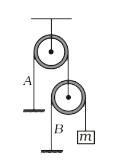A heavy mass m is hanging from a string in equilibrium without breaking it. When this same mass is set into oscillation, the string breaks, Explain.
Step-by-Step Solution:
1. Understanding the Setup:
- We have a mass m hanging from a string in equilibrium. In this state, the only forces acting on the mass are the gravitational force mg acting downward and the tension T1 in the string acting upward.
2. Equilibrium Condition:
- In equilibrium, the tension in the string must balance the weight of the mass. Thus, we have:
T1=mg
3. Setting the Mass into Oscillation:
- When the mass is set into oscillation, it will not only experience the gravitational force but also additional forces due to its motion. The tension in the string during oscillation will change.
4. Analyzing Forces During Oscillation:
- When the mass oscillates, we can consider the forces acting on it at a certain angle θ from the vertical. The tension in the string at this point is T2.
- The components of the forces acting on the mass are:
- The gravitational force mg acting downward.
- The tension T2 acting along the string.
5. Applying Newton’s Second Law:
- The net force acting towards the center of the circular path (centripetal force) can be expressed as:
T2−mgcos(θ)=mv2R
- Here, R is the radius of the circular path, and v is the velocity of the mass.
6. Rearranging the Equation:
- From the equation above, we can express T2 as:
T2=mgcos(θ)+mv2R
7. Considering Small Angles:
- For small angles θ, cos(θ) is approximately equal to 1. Therefore, we can simplify:
T2≈mg+mv2R
8. Comparing Tensions:
- In the equilibrium state, we found that T1=mg.
- In the oscillating state, T2 is greater than T1 because it includes an additional term mv2R which is positive (since the mass is in motion).
9. Conclusion:
- Since T2>T1, the tension in the string during oscillation exceeds the tension when the mass is at rest. This increased tension can lead to the string breaking if it exceeds the maximum tensile strength of the string.
Final Statement:
Thus, the string breaks when the mass is set into oscillation because the tension in the string during oscillation exceeds the tension when the mass is in equilibrium.
---
- We have a mass m hanging from a string in equilibrium. In this state, the only forces acting on the mass are the gravitational force mg acting downward and the tension T1 in the string acting upward.
- In equilibrium, the tension in the string must balance the weight of the mass. Thus, we have:
T1=mg
- When the mass is set into oscillation, it will not only experience the gravitational force but also additional forces due to its motion. The tension in the string during oscillation will change.
- When the mass oscillates, we can consider the forces acting on it at a certain angle θ from the vertical. The tension in the string at this point is T2.
- The components of the forces acting on the mass are:
- The gravitational force mg acting downward.
- The tension T2 acting along the string.
- The net force acting towards the center of the circular path (centripetal force) can be expressed as:
T2−mgcos(θ)=mv2R
- Here, R is the radius of the circular path, and v is the velocity of the mass.
- From the equation above, we can express T2 as:
T2=mgcos(θ)+mv2R
- For small angles θ, cos(θ) is approximately equal to 1. Therefore, we can simplify:
T2≈mg+mv2R
- In the equilibrium state, we found that T1=mg.
- In the oscillating state, T2 is greater than T1 because it includes an additional term mv2R which is positive (since the mass is in motion).
- Since T2>T1, the tension in the string during oscillation exceeds the tension when the mass is at rest. This increased tension can lead to the string breaking if it exceeds the maximum tensile strength of the string.
Thus, the string breaks when the mass is set into oscillation because the tension in the string during oscillation exceeds the tension when the mass is in equilibrium.
Topper's Solved these Questions
- CIRCULAR MOTIONBOOK - HC VERMA ENGLISHCHAPTER - CIRCULAR MOTIONEXERCISE - Exercises
30 Videos
- CENTRE OF MASS, LINEAR MOMENTUM, COLLISIONBOOK - HC VERMA ENGLISHCHAPTER - CENTRE OF MASS, LINEAR MOMENTUM, COLLISIONEXERCISE - Objective -2
11 Videos
- FLUID MECHANICSBOOK - HC VERMA ENGLISHCHAPTER - FLUID MECHANICSEXERCISE - All Questions
90 Videos
Similar Questions
The block of mass m is at rest. Find the tension in the string A .

View SolutionA ball of mass 2kg hanging from a spring oscillates with a time period 2π seconds. Ball is removed when it is in equilibrium position, then spring shortens by
View SolutionA heavy particle of mass 0.50 kg is hanging from a string fixed with the roof. Find the force exerted by the string on the particle. Take g=9.8ms2
 .
.
View SolutionA block of silver of mass 4kg hanging from a string is immersed in a liquid of relative density 0.72. If relative density of silver is 10, then tension in the string will be
View SolutionA block of silver of mass 4kg hanging from a string is immersed in a liquid of relative density 0.72. If relative density of silver is 10, then tension in the string will be
View SolutionA boy is whirling a stone tied with a string in a horizontal circular path. When the string breaks, the stone
View SolutionTwo identical small charged spheres, each having a mass m, hang in equilibrium the length of each string is l, and the angle made by any string with the vertical is θ. Find the magnitude of the charge on each sphere.
View SolutionA block of mass m hangs from three springs having same spring constant k. If the mass is slightly displaced downwards, the time period of oscillation will be

View SolutionA block of mass m hangs from a vertical spring of spring constant k. If it is displaced from its equilibrium position, find the time period of oscillations.
View SolutionA uniform disc of mass M and radius R is mounted on a fixed horizontal axis. A block of mass m hangs from a massless string that is wrapped around the rim of the disc. The magnitude of the acceleration of the falling block (m) is
View Solution
